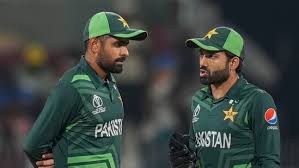When Stars Fall What Dropping Babar and Rizwan Signifies
By Hassaan Ahmad Awan

When Stars Fall: What Dropping Babar and Rizwan Signifies
In Pakistan, cricket is not just a sport; it is an arena where national pride, cultural sentiment, and political undercurrents collide. Few names in recent years have carried as much weight as Babar Azam and Mohammad Rizwan. From breathtaking batting partnerships to stabilizing a fragile cricketing system, they became more than players—they became symbols of continuity in a turbulent cricketing landscape.
But with reports and speculations suggesting the possibility of benching or sidelining senior stars like Babar and Rizwan to make way for new entrants, Pakistan finds itself standing at the edge of both transition and turmoil. This is not simply about team selection; it is about the broader cultural, psychological, and strategic implications of such moves.
Cricket as Cultural Identity in Pakistan
To understand why the sidelining of cricket icons is such a contentious issue, one must recognize the place of cricket in Pakistan’s cultural DNA. Matches are not just games—they are collective rituals that bind together millions across divides of class, language, and region.
Babar and Rizwan, through their consistency and leadership, embodied resilience. Babar’s elegant stroke play and Rizwan’s gritty determination became aspirational metaphors for a nation often battling crises yet determined to rise again. Removing them from the central stage is not merely a tactical choice—it sends a signal of cultural dislocation to fans who equate cricketing continuity with national stability.
The Strategic Angle: Renewal vs. Risk
Every cricketing system faces a moment when the torch must be passed to a new generation. Benchmarks from other nations illustrate this well. Australia phased out giants like Ricky Ponting and Michael Clarke, but it was carefully timed to preserve continuity. India too transitioned from Tendulkar, Dhoni, and Kohli phases by gradually nurturing younger stars while ensuring senior figures remained in mentoring roles.
Pakistan’s challenge is sharper. By sidelining experienced performers too abruptly, the team risks destabilizing the dressing room culture. Babar and Rizwan are not just run-scorers; they are anchors of strategic stability. Their presence assures fans and players alike that even in collapse, there is experience to rely upon.
Replacing them prematurely could result in short-term disruptions, particularly in high-pressure tournaments like the ICC T20 World Cup or bilateral series against archrivals India. Without tested hands, younger entrants may falter under the cultural and psychological weight of expectations.
The Economics of Icons
Beyond strategy, there is a financial ecosystem tied to icons. Players like Babar and Rizwan drive ticket sales, advertising contracts, and brand loyalty. Broadcasters market series on the back of their star power. Sponsors align campaigns with their recognizability.
If these icons are benched, revenue streams risk shrinking in the short term. While new faces eventually bring fresh marketing opportunities, they cannot immediately replace the aura or commercial pull of established legends. For a cricket board often struggling with finances, such abrupt changes can be more than symbolic—they can become economically disruptive.
The Dressing Room Dynamics
Another overlooked dimension is leadership and mentorship. Senior players act as cultural custodians within the team environment. They embody professionalism, guide young players on handling pressure, and often protect management from complete fallout.
Removing such figures risks leaving a vacuum of leadership. A squad of purely fresh entrants may lack the resilience needed to bounce back from collapses or media scrutiny. In Pakistan, where politics and cricket often intersect, experienced players also provide a shield against administrative controversies.
Thus, sidelining Babar and Rizwan without a clear leadership succession plan may breed uncertainty rather than progress.
Fans, National Psyche, and the Idea of Betrayal
Perhaps the most visceral impact lies in the emotional contract between fans and their heroes. Cricket fans in Pakistan invest not just loyalty but also identity in players. Babar and Rizwan’s partnership symbolized hope during a time when political, economic, and environmental crises dominated headlines.
To suddenly see them benched may feel, to many, like betrayal. Fans often read such moves as reflective of larger injustices in the system—politics interfering with merit, internal board politics undermining performance, or a disregard for loyalty.
This disconnect between fans and management can trigger cultural backlash: from social media campaigns to falling stadium attendance. For a country where cricket is the last unifying cultural glue, such alienation can deepen divides rather than heal them.
Transition Done Right: Lessons from History
The question, then, is not whether Pakistan should transition toward new talent—it must. But the method matters. Gradual integration, where younger players share dressing rooms, learn under pressure alongside icons, and inherit responsibilities over time, is the sustainable model.
Benching Babar and Rizwan outright risks turning transition into turmoil. Pakistan’s cricket board must therefore study the template of managed exits seen in other cricketing cultures. Senior players can be rotated strategically, given selective formats, or even assigned mentoring roles that keep their symbolic value intact while opening pathways for fresh faces.
The Broader Symbolism: Stability vs. Instability
At a deeper level, this debate reflects how Pakistan handles institutional change. Too often, transitions in politics, governance, and even sport are abrupt, marked by breakage rather than continuity. Cricket, as a microcosm of society, mirrors this fault line.
Benching cricket icons without carefully orchestrating succession underscores a national pattern: the tendency to confuse change with disruption. The implications stretch beyond cricket, reflecting how institutions struggle to adapt without alienating stakeholders.
Conclusion: Between Reverence and Renewal
The story of Babar Azam and Mohammad Rizwan is not just about two cricketers—it is about Pakistan’s relationship with continuity, stability, and identity. Icons cannot play forever, but their exit must be managed with dignity, foresight, and cultural sensitivity.
Dropping them unceremoniously would risk alienating fans, destabilizing strategy, and undermining revenue. On the other hand, carefully phased transitions could set the tone for how Pakistan balances renewal with respect across other national institutions.
When stars fall, the sky can either grow darker—or it can reveal new constellations. The choice for Pakistan’s cricket leadership is to ensure that transition does not descend into turmoil.
✍️ By Hassaan Ahmad Awan
Writer, columnist, and blogger at hassaanahmadawan.com, where I explore Pakistan’s society, culture, politics, and environment with a critical yet hopeful lens.
Urdu Version Of Column :
جب ستارے گرتے ہیں: بابَر اور رضوان کو باہر کرنے کے مضمرات
پاکستان میں کرکٹ صرف ایک کھیل نہیں، بلکہ ایک جذباتی ثقافتی دھاگا ہے جو کروڑوں مداحوں کو باندھتا ہے۔ ایسے میں جب اسٹار کھلاڑی جیسے بابَر اعظم اور محمد رضوان کو ٹیم سے باہر بٹھا دیا جائے یا ان کی جگہ نئے چہروں کو دی جائے، تو اس فیصلے کی گونج صرف میدانِ کرکٹ تک محدود نہیں رہتی۔ یہ قومی شناخت، کھیلوں کی سیاست، اور اس ملک کے اسٹریٹجک وژن پر بھی اثر انداز ہوتی ہے۔ سوال یہ نہیں کہ کون کھیلے گا اور کون باہر بیٹھے گا، بلکہ یہ ہے کہ یہ فیصلے پاکستان کے کھیلوں کے ڈھانچے اور اجتماعی شعور کے لیے کیا معنی رکھتے ہیں۔
کرکٹ اور قومی جذبات
پاکستانی معاشرے میں کرکٹ کے ہیرو کسی حد تک “قوم کے ہیرو” کا درجہ رکھتے ہیں۔ بابَر اعظم اور محمد رضوان گزشتہ ایک دہائی میں اس عہدے تک پہنچے جہاں ان کی کامیابیاں قوم کے دکھوں کو بھلاتی اور ناکامیاں لوگوں کے دلوں پر بوجھ ڈال دیتی تھیں۔ جب ایسے کھلاڑیوں کو بینچ پر بٹھایا جاتا ہے تو یہ صرف ایک “ٹیم مینجمنٹ کا فیصلہ” نہیں ہوتا بلکہ شائقین کے لیے ایک جھٹکا ہوتا ہے۔ یہ تبدیلی ایک ایسے سفر کی علامت ہے جہاں ماضی کے ستارے آہستہ آہستہ غروب ہو رہے ہیں اور نئے ستارے افق پر طلوع ہو رہے ہیں۔
پرفارمنس بمقابلہ شناخت
کرکٹ کی دنیا میں میرٹ اور کارکردگی کا فلسفہ بہت مضبوط ہے۔ لیکن پاکستان جیسے ممالک میں جہاں کھیل عوامی جذبات اور قومی شناخت سے جڑا ہوا ہے، وہاں یہ فیصلہ ہمیشہ صرف “کارکردگی کی بنیاد” پر نہیں سمجھا جاتا۔ بابر اعظم یا محمد رضوان کو آرام دینے کا فیصلہ بظاہر کارکردگی یا نئے ٹیلنٹ کو موقع دینے کی حکمتِ عملی کا حصہ ہے، لیکن عوامی تاثر میں یہ کبھی کبھی “ہیروز کی بے قدری” کے طور پر لیا جاتا ہے۔
نئے چہرے اور نئی حکمتِ عملی
نئے کھلاڑیوں کو ٹیم میں جگہ دینے کا مقصد مستقبل کے لیے ایک مضبوط بنیاد رکھنا ہے۔ لیکن یہ تبدیلی پاکستان جیسے ملک میں جہاں کرکٹ ایک ثقافتی بیانیہ ہے، ہمیشہ آسان نہیں ہوتی۔ نیا کھلاڑی نہ صرف اپنی کارکردگی سے، بلکہ اپنے رویے، مزاج اور شخصیت سے بھی پرکھا جاتا ہے۔ ایک کامیاب ڈبیو یا چند اہم اننگز عوام کو قائل کر سکتی ہیں، لیکن اسٹارڈم حاصل کرنے میں وقت لگتا ہے۔ اس دوران عوامی ردعمل اکثر تنقید، شکوک اور مایوسی سے بھرا ہوتا ہے۔
اسٹریٹجک مضمرات
بین الاقوامی سطح پر بھی یہ فیصلے ایک تاثر چھوڑتے ہیں۔ مخالف ٹیمیں اور مبصرین یہ دیکھتے ہیں کہ پاکستان اپنی ٹیم کے ساتھ کس طرح تجربات کر رہا ہے۔ یہ اس بات کا عندیہ بھی ہو سکتا ہے کہ پاکستان کرکٹ بورڈ ایک لمبے وژن پر چل رہا ہے، لیکن یہ کمزوری کا تاثر بھی پیدا کر سکتا ہے کہ ٹیم اپنے اسٹارز کے بغیر غیر یقینی کی کیفیت میں ہے۔
ثقافتی تناظر
بابر اعظم اور محمد رضوان جیسے کھلاڑیوں کو پاکستانی معاشرے میں رول ماڈل کے طور پر دیکھا جاتا ہے۔ انہیں بینچ پر بیٹھانے کا مطلب صرف ایک “کھیلوں کا فیصلہ” نہیں بلکہ یہ بھی ہے کہ ایک نسل کے ہیروز کو آہستہ آہستہ پسِ پردہ کیا جا رہا ہے تاکہ نئی نسل اپنے ہیروز تلاش کر سکے۔ یہ تبدیلی کسی بھی معاشرے کے لیے مشکل ہوتی ہے کیونکہ یہ اجتماعی یادداشت میں ایک خلا پیدا کرتی ہے۔
نتیجہ
کرکٹ میں ستاروں کا عروج اور زوال ایک فطری عمل ہے۔ لیکن پاکستان جیسے ملک میں جہاں یہ کھیل قومی جذبات کا سب سے بڑا اظہار ہے، وہاں یہ عمل زیادہ حساس اور پیچیدہ ہو جاتا ہے۔ بابر اور رضوان کو بینچ پر بٹھانے کے فیصلے نے یہ سوال کھڑا کر دیا ہے کہ آیا یہ صرف کھیل کی حکمتِ عملی ہے یا ایک بڑی ثقافتی اور اسٹریٹجک تبدیلی کی علامت۔ شاید وقت ہی بتائے گا کہ یہ فیصلہ ایک کامیاب “ٹرانزیشن” ہوگا یا ایک خطرناک “ٹرمائل”۔
✍️ حسان احمد اعوان
ماہرِ تعلیم ، بلاگر، اور کالم نگار


